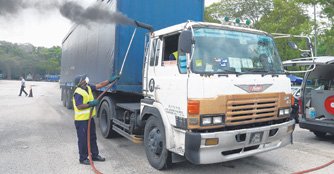Singapore targets highest vehicle emission mark
23 Jun 2014|5,973 views
Singapore will adopt the stringent Euro 6 emission standards for both petrol and diesel powered vehicles as early as 2017. The move makes the city-state possibly the first country in the region to embrace the highest emission regulations in a bid to reduce harmful exhaust gases. Presently, the standards stand at Euro 4 and 5 for petrol and diesel power respectively.

These ultra-fine particulates make up the bulk of particulate emissions and are very small and light, added the English daily. In addition, the Ministry revealed that implementing Euro 6 standards would also reduce emissions of another harmful air pollutant - Nitrogen Oxides.
Although an exact implementation date has not been decided upon, motor industry players told the English daily they have been informed of a rollout of the regulation in the second half of 2017.
While European automakers are confident that they will be able to meet the deadline, the regulation currently poses a challenge for Japanese automakers, as there are no equivalent standards there as of now. A Toyota Motor Asia-Pacific spokesman revealed that the firm is reviewing its product strategy while working closely with the Japan Automobile Manufacturers Association, who has provided input to the National Environment Agency.
Interestingly, in contrast, oil companies - whose products such as petrol and diesel also have to burn more cleanly under the new standards - have a longer time to comply. Currently, such products here need to meet Euro 4 standards only. According to The Straits Times, oil companies have up to December 2018 to meet the Euro 5 standard for petrol and January 2018 for diesel.
Singapore will adopt the stringent Euro 6 emission standards for both petrol and diesel powered vehicles as early as 2017. The move makes the city-state possibly the first country in the region to embrace the highest emission regulations in a bid to reduce harmful exhaust gases. Presently, the standards stand at Euro 4 and 5 for petrol and diesel power respectively.
Responding to queries from The Straits Times, The Ministry of the Environment and Water Resources explained that the aim was 'to address the concern that recently popular compression injection diesel engines and gasoline direct injection engines actually increase the emissions of ultra-fine particulates'.
These ultra-fine particulates make up the bulk of particulate emissions and are very small and light, added the English daily. In addition, the Ministry revealed that implementing Euro 6 standards would also reduce emissions of another harmful air pollutant - Nitrogen Oxides.
Although an exact implementation date has not been decided upon, motor industry players told the English daily they have been informed of a rollout of the regulation in the second half of 2017.
While European automakers are confident that they will be able to meet the deadline, the regulation currently poses a challenge for Japanese automakers, as there are no equivalent standards there as of now. A Toyota Motor Asia-Pacific spokesman revealed that the firm is reviewing its product strategy while working closely with the Japan Automobile Manufacturers Association, who has provided input to the National Environment Agency.
Interestingly, in contrast, oil companies - whose products such as petrol and diesel also have to burn more cleanly under the new standards - have a longer time to comply. Currently, such products here need to meet Euro 4 standards only. According to The Straits Times, oil companies have up to December 2018 to meet the Euro 5 standard for petrol and January 2018 for diesel.
Latest COE Prices
August 2025 | 2nd BIDDING
NEXT TENDER: 03 Sep 2025
CAT A$104,524
CAT B$124,400
CAT C$72,190
CAT E$125,001
View Full Results Thank You For Your Subscription.


















